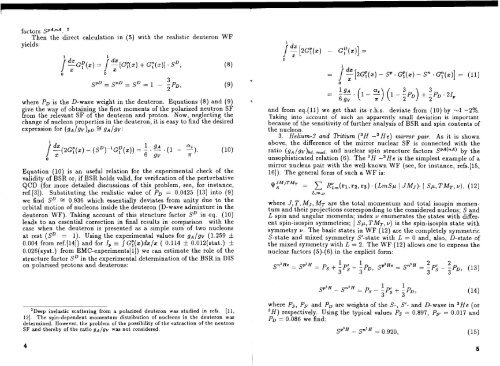Bjorken Sum Rule and Deep Inelastic Scattering on Polarized ... - JINR
Bjorken Sum Rule and Deep Inelastic Scattering on Polarized ... - JINR
Bjorken Sum Rule and Deep Inelastic Scattering on Polarized ... - JINR
You also want an ePaper? Increase the reach of your titles
YUMPU automatically turns print PDFs into web optimized ePapers that Google loves.
factors<br />
Then the direct calculati<strong>on</strong> in (5) with the realistic deuter<strong>on</strong> WE<br />
yields:<br />
/ @Gf x<br />
1 1<br />
(x) = / :[G:(x)<br />
+ G;(x)l. sD,<br />
dx<br />
/-[~G:(x) - Gf (x)] =<br />
x<br />
0<br />
where PD is the D-wave weight in the deuter<strong>on</strong>. Equati<strong>on</strong>s (8) <str<strong>on</strong>g>and</str<strong>on</strong>g> (9)<br />
ive the way of obtaining the first moments of the polarized neutr<strong>on</strong> SF<br />
from the relevant SF of the deuter<strong>on</strong> <str<strong>on</strong>g>and</str<strong>on</strong>g> prot<strong>on</strong>. Now, neglecting the<br />
change of nucle<strong>on</strong> properties in the deuter<strong>on</strong>, it is easy to find the desired<br />
expressi<strong>on</strong> for (gA/gV)pD gA/gV:<br />
1<br />
1 gA 03<br />
/ :(~G:(x) - (sD)-'Gf (x)) = - .- . (1 - -).<br />
0<br />
6 gv 7r<br />
Equati<strong>on</strong> (10) is an useful relati<strong>on</strong> for the experimental check of the<br />
validity of BSR or, if BSR holds valid, for verificati<strong>on</strong> of the perturbative<br />
QCD (for more detailed discussi<strong>on</strong>s of this problem, see, for instance,<br />
ref.131). Substituting the realistic value of PD = 0.0425 1131 into (9)<br />
we find SD Z 0.936 which essentially deviates from unity due to the<br />
orbital moti<strong>on</strong> of nucle<strong>on</strong>s inside the deuter<strong>on</strong> (D-wave admixture in the<br />
deuter<strong>on</strong> WE). Taking account of this structure factor SD in eq. (10)<br />
leads to an essential correcti<strong>on</strong> in final results in comparis<strong>on</strong> with the<br />
case when the deuter<strong>on</strong> is presented as a simple sum of two nucle<strong>on</strong>s<br />
at rest (SD = 1). Using the experimental values for gA/gv (1.259 f<br />
0.004 from ref.[14]) <str<strong>on</strong>g>and</str<strong>on</strong>g> for I, JG~(x)dx/x ( 0.114 f O.O12(stat.) k<br />
0.026(syst .) from EMC-experiments[l]) we can estimate the role of the<br />
structure factor SD in the experimental determinati<strong>on</strong> of the BSR in DIS<br />
<strong>on</strong> polarized prot<strong>on</strong>s <str<strong>on</strong>g>and</str<strong>on</strong>g> deuter<strong>on</strong>s:<br />
<str<strong>on</strong>g>and</str<strong>on</strong>g> from eq.(ll) we get that its r.h.s. deviate from (10) by -1 -2%.<br />
Taking into account of such an apparently small deviati<strong>on</strong> is important<br />
because of the sensitivity of further analysis of BSR <str<strong>on</strong>g>and</str<strong>on</strong>g> spin c<strong>on</strong>tents of<br />
the nucle<strong>on</strong>.<br />
3. Helium-3 <str<strong>on</strong>g>and</str<strong>on</strong>g> Tritium (3H -3 He) mirror pair. As it is shown<br />
above, the difference of the mirror nuclear SF is c<strong>on</strong>nected with the<br />
ratio (gA/gV)bd. nucl. <str<strong>on</strong>g>and</str<strong>on</strong>g> nuclear spin structure factors SpA(nA) by the<br />
unsophisticated relati<strong>on</strong> (6). The 3H -3He is the simplest example of a<br />
mirror nucleus pair with the well-known WE (see, for instance, refs.[l5,<br />
161). The general form of such a WE is:<br />
~~MJTMT =<br />
1 Ri,(rl, r2, r3) . (LmSp I JMJ). I Sp, TMT, v), (12)<br />
L,m,w<br />
where J,T, Mj, MT are the total momentum <str<strong>on</strong>g>and</str<strong>on</strong>g> total isospin momentum<br />
<str<strong>on</strong>g>and</str<strong>on</strong>g> their projecti<strong>on</strong>s corresp<strong>on</strong>ding to the c<strong>on</strong>sidered nucleus; S <str<strong>on</strong>g>and</str<strong>on</strong>g><br />
L spin <str<strong>on</strong>g>and</str<strong>on</strong>g> angular momenta; index v enumerates the states with different<br />
spin-isospin symmetries; I Sp, TMT, v) is the spin-isospin state with<br />
symmetry v. The basic states in WE (12) are the completely symmetric<br />
S-state <str<strong>on</strong>g>and</str<strong>on</strong>g> mixed symmetry St-state with L = 0 <str<strong>on</strong>g>and</str<strong>on</strong>g>, also, D-state of<br />
the mixed symmetry with L = 2. The WE (12) allows <strong>on</strong>e to express the<br />
nuclear factors (5)-(6) in the explicit form:<br />
'<str<strong>on</strong>g>Deep</str<strong>on</strong>g> inelastic scattering from a polarized deuter<strong>on</strong> was studied in refs. [ll,<br />
121. The spin-dependent illoillentunl distributi<strong>on</strong> of nucle<strong>on</strong>s in the deuter<strong>on</strong> was<br />
determined. However, the problein of the possibility of the extracti<strong>on</strong> of the neutr<strong>on</strong><br />
SF <str<strong>on</strong>g>and</str<strong>on</strong>g> thereby of the ratio gA/gv was not c<strong>on</strong>sidered.<br />
where Ps, PSI <str<strong>on</strong>g>and</str<strong>on</strong>g> PD are weights of the S-, St- <str<strong>on</strong>g>and</str<strong>on</strong>g> D-wave in 3He (or<br />
3H) respectively. Using the typical values Ps = 0.897, Pst = 0.017 <str<strong>on</strong>g>and</str<strong>on</strong>g><br />
PD = 0.086 we find:<br />
4

















